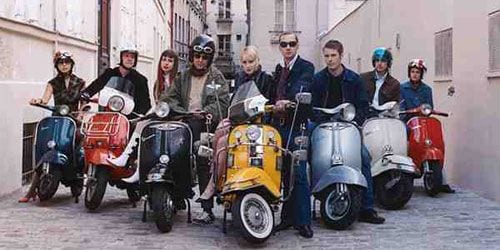
The Who weren’t mods. Peter Townshend’s ferocious quartet definitely loved rhythm-and-blues, and occasionally adopted a nattishly Mod sartorial appearance, but their hell-bent noise – and Townshend’s ambitions to be a pop Holden Caulfield — couldn’t be sequestered under any trendy umbrella. Still, they inarguably benefited from the mod set’s interest in their early years. They repaid this debt with their sixth studio album, Quadrophenia, released in 1973, and conceived as a love letter to the British mod scene of the early ’60s. What commentator Alan Clayson terms the “last big concept album” would later be adapted into a film, following the band’s triumphant Tommy.
“Mods”, or Modernists, were young Briton lads who donned smart suits and parkas, rode gleaming Vespas, and shook their groove things to black music, most notably that flowing from the Motown studios. They co-existed – often contentiously – alongside the so-called Teddy Boys, England’s greasers, for lack of a better term. Alec Lindsell’s new documentary The Who, the Mods, and the Quadrophenia Connection, explores the links between mod subculture, Her Majesty’s loudest band, and the various incarnations of Quadrophenia.
The mod scene passed through several iterations before they ‘discovered’ the Who. Dating back to the late ’50s, mods – like hipper-than-thou Beatniks — initially embraced jazz, before that sound was steamrollered by rock ‘n’ roll and demoted to elevator music in the minds of randy young men. The boys quickly switched gears, glomming on to African-American sounds from across the pond, Motown, Stax, whatever. Indeed, “Green Onions” became an unofficial anthem for mods, and woe to any amateur mod act that declined to perform it.
In those halcyon musical days, the Mason-Dixon line between rock and R & B was a noticeably porous one, and mods jonesed for some of Britain’s new rock outfits of the era, including the Kinks, the Small Faces, and of course, the Who. Townshend’s raucous new band was evolving at lightning speed, and this was reflected in their frequent name changes; the Detours begat the mod-friendly the High Numbers which begat the whimsically mysterious the Who. In fact, Townshend sought to re-fashion his hard-partying bandmates into mods, but this concept never really gelled.
Still, the mods remained faithful to the group, adopting “My Generation” as a personal clarion call. Townshend’s writing had certainly captured the pulse of this snarky, proto-punk generation, and proved hugely influential to later would-be Mods, such as Paul Weller, a dour, left-leaning Townshend disciple who came to be known as the “Modfather” after fronting the massively popular post-punk band the Jam during the early Thatcher years.
Mod culture waxed and waned through the Who’s glory days, and Townshend decided – after Tommy’s gleeful reception – to craft a second concept piece, one which would detail the lives of some working-class mates in ’60s England who happened to be mods. He chose the title Quadrophenia, and quadraphonic sound was intended for the recording sessions, but this sonic Cinerama proved unworkable and was soon scrapped.
Musically, however, Quadrophenia’s aural textures are distinctly more complex than the leaner, garagey feel of classic mod bands, especially the percussive bombast of Keith Moon’s drumming. I’m reminded of those who criticized Grease for straining elemental ’50s rock through a ’70s, occasionally discoish filter. It may be that Quadrophenia is best seen as a missing socio-cultural link between postwar England and its strife-torn, IRA-fearing ’70s, which produced the brattier, more scabrous punks, whose economic futures were far more tenuous than their mod predecessors.
The rise of spiky-haired, safety pin-clad ‘revolutionaries’ shouldn’t suggest that mods ever vanished completely. The success of the Jam and 1979’s release of a film adaptation of Quadrophenia brought them out of the shadows, and they occupied a rung on Britain’s ladder of flamboyant youth sub-cultures. Curiously, the film – directed by Franc Roddam and featuring a young, flaxen-haired Sting as a thuggish mod leader — briefly amplified the mod phenomenon, then apparently obliterated it. As one commentator makes clear, whenever a youthful fad becomes too popular, it withers and dies, perhaps because hipness can never truly be a mass movement, despite the relentless efforts by Madison Avenue – and maybe Carnaby Street – to make it so.
The extras in this DVD package are slight, but do include recollections from the Who’s “Mr Fixit”, Richard Barnes, who reminisces about recording Quadrophenia in an ancient church which had to be fitted with state-of-the-art audio equipment, and also biographies of many journalist and scenesters associated with ’60s and ’70s British pop culture, among them Paolo Hewitt, Buddy Ascot, and the esteemed album producer Ron Nevison.
Quadrophenia, the album, can be seen as a melodic pre-punk opera, and The Who, The Mods, and The Quadrophenia Connection will undoubtedly appeal most to viewers who concur. As a history-geek Anglophile, I enjoyed listening to the majestic soundtrack as Lindsell raided the pop dustbin for images and tidbits of info I was never privy to. Let’s pray it doesn’t get buried in a 2AM time slot on VH1.
I came late to the Who, ignoring the band through my teen years, until discovering the criminally underrated post-Moon “You Better, You Bet” in my early 20s. As I write this, I’m hallucinating a fantasy gig: The Who, The Jam, Midnight Oil (who were asked to support the group on their “farewell” tour, but begged off). Anyone familiar with all three knows I need say no more. The Sound and The Fury…

![Call for Papers: All Things Reconsidered [MUSIC] May-August 2024](https://www.popmatters.com/wp-content/uploads/2024/04/all-things-reconsidered-call-music-may-2024-720x380.jpg)



